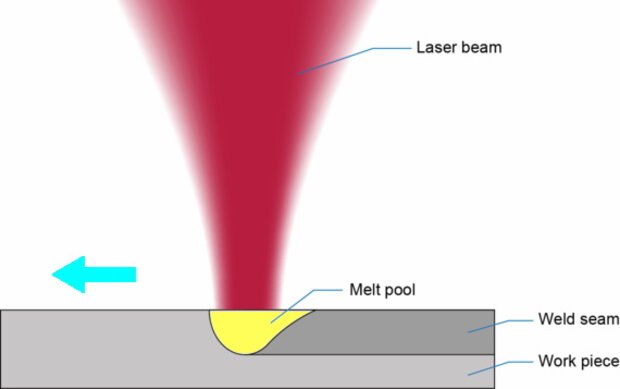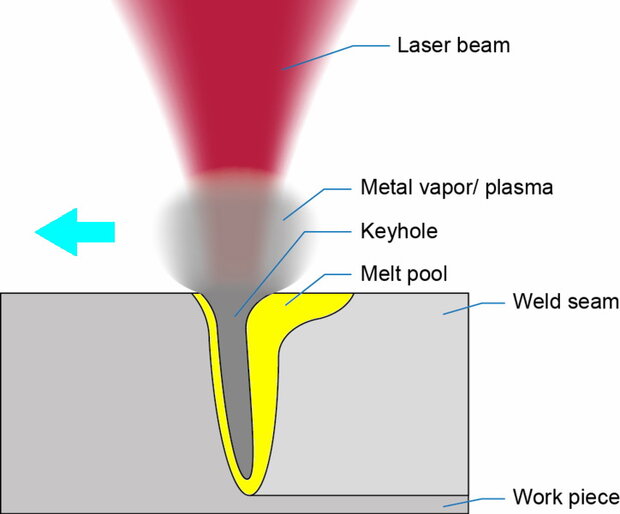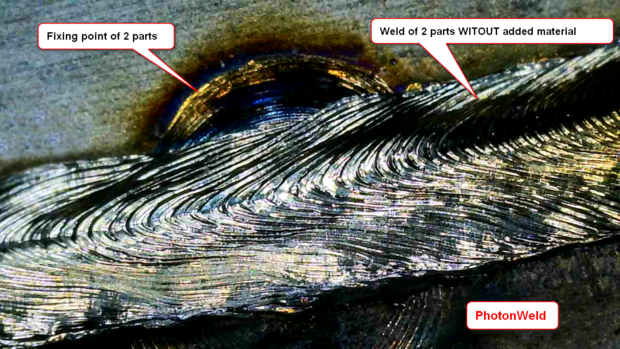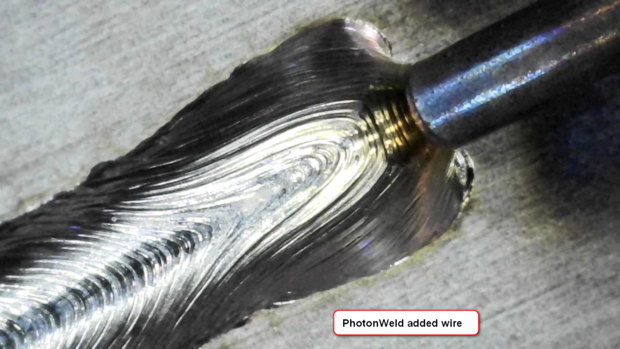Laser welding can be divided into the following TWO major processes:
Heat conduction welding and Keyhole (deep penetration) welding
Fiber laser welding is a high power density process that provides a unique welding capability to maximize penetration with minimal heat input. The weld is formed as the intense laser light rapidly heats the material – typically in fractions of milliseconds. There are two types of welds, based on the power density contained within the focus spot size: conduction modeand penetration/keyhole mode. A third type named as transition keyhole mode is the combination of the conduction mode and penetration/keyhole mode.
Conduction mode laser welding
Conduction mode welding is performed at low energy density, typically around 0.5 MW/cm², forming a weld nugget that is shallow and wide. The heat to create the weld into the material occurs by conduction from the surface. Typically this can be used for applications that require an aesthetic weld or when particulates are a concern, such as certain battery sealing applications.
Heat conduction welding is a laser welding method that features a low power output laser beam. This makes for a penetration depth of no more than 1 to 2 mm. With the ability to handle a relatively wide power range, heat conduction welding can be adjusted to the ideal power level, and the shallow penetration makes it possible to weld materials that are susceptible to heat effects under optimal conditions.
This welding type is used for butt joints, lap joints, and other welding applications for thin plates, and can also be used for welding hermetic seals and other seals. Heat conduction welding is also suitable for volatile alloys such as magnesium and zinc, for which keyhole (deep penetration) welding is not suitable.
Transition mode laser welding
Combined penetration and conduction mode laser welding
Transition mode laser welding occurs at medium power density, around 1 MW/cm2, and results in more penetration than conduction mode due to the creation of what is known as the “keyhole.” The keyhole is a column of vaporized metal that extends into the material; its diameter is much smaller than the weld width and is sustained against the forces of the surrounding molten material by vapor pressure. The depth of the keyhole into the material is controlled by power density and time. Because the optical density of the keyhole is low it acts as a conduit to deliver the laser power into the material.
Penetration mode laser welding or Keyhole mode laser welding
Keyhole or penetration mode welding – Increasing the peak power density beyond 1.5MW/cm2 shifts the weld to keyhole mode, which is characterized by deep narrow welds with an aspect ratio greater than 1.5. The penetration depth rapidly increases when the peak power density is beyond 1 MW/cm2, transitioning the weld mode from conduction to keyhole/penetration welding.
Penetration or keyhole mode welding is characterized by narrow welds. This direct delivery of laser power into the material maximizes weld depth and minimizes the heat into the material, reducing the heat affected zone and part distortion. In this keyhole mode, the weld can be either completed at very high speeds – in excess of 500mm per second with small penetration typically under 0.5 mm – or at lower speed, with deep penetration up to 12 mm.
Keyhole welding (deep penetration welding) uses a high power output laser beam for high-speed welding. The narrow, deep penetration allows for uniform welding of internal structures. Because the heat-affected zone is very small, distortion of the base material, due to the heat from the welding, will be minimized.
This method is suitable for applications requiring deep penetration or when welding multiple base materials stacked together (including for butts, corners, Ts, laps, and flange joints).
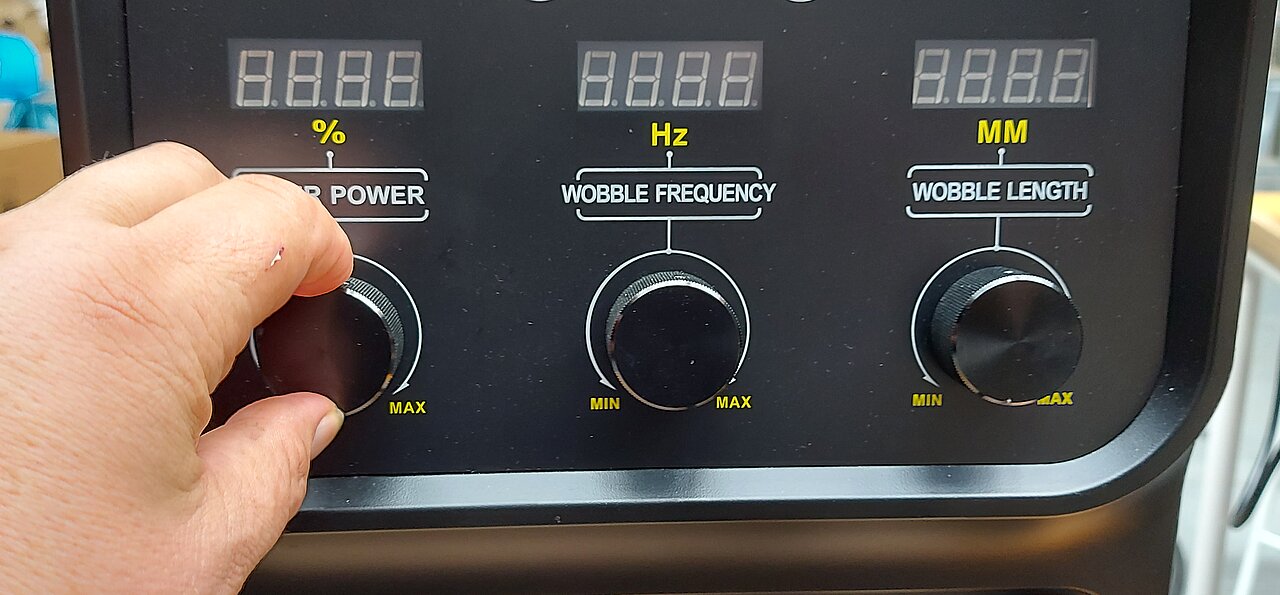
Laser Welding Process Parameters
Understanding the basic laser welding process parameters is the key to your success!
Power density
Power density is one of the most critical parameters in laser processing. With a higher power density, the surface layer can be heated to the boiling point in the microsecond time range, resulting in a large amount of vaporization.
Therefore, high power density is advantageous for material removal processing such as punching, cutting, and engraving. For lower power densities, the surface temperature reaches the boiling point and takes several milliseconds. Before the surface layer is vaporized, the bottom layer reaches the melting point, and it is easy to form a good fusion weld.
Therefore, in conduction laser welding, the power density is in the range of 10^4~10^6W/CM^2.
Laser pulse waveform
Laser pulse waveforms are an important issue in laser welding, especially for sheet welding. When a high-intensity laser beam is incident on the surface of the material, the metal surface will be reflected by 60 to 98% of the laser energy and the reflectivity will vary with the surface temperature. During a laser pulse action, the metal reflectivity changes greatly.
Laser pulse width
Pulse width is one of the important parameters of pulse laser welding. It is an important parameter that is different from material removal and material melting, and is also a key parameter that determines the cost and volume of processing equipment.
The effect of the defocus amount on the weld quality
Laser welding usually requires a certain amount of defocus because the power density at the center of the spot at the laser focus is too high and it is easy to evaporate into holes. The power density distribution is relatively uniform across the planes exiting the laser focus.
There are two ways of defocusing: positive defocusing and negative defocusing.
The focal plane is located above the workpiece for positive defocusing, and vice versa for negative defocus. According to the theory of geometric optics, when the distance between the positive and negative defocus planes and the welding plane are equal, the power density on the corresponding plane is approximately the same, but the shape of the molten pool obtained is actually different. In the case of negative defocusing, a greater penetration can be obtained, which is related to the formation of the molten pool.
Experiments have shown that the laser heating 50~200us material begins to melt, forming liquid phase metal and partially vaporizing, forming high pressure steam, and spraying at a very high speed, emitting dazzling white light. At the same time, the high concentration vapor moves the liquid metal to the edge of the bath and forms a depression in the center of the bath.
When negative defocusing, the internal power density of the material is higher than the surface, and it is easy to form a stronger melting and vaporization, so that the light energy is transmitted to the deeper part of the material. Therefore, in practical applications, when the penetration depth is required to be large, negative defocusing is used; when welding thin materials, positive defocusing is preferred.
Welding speed
The speed of the welding speed will affect the heat input per unit time. If the welding speed is too slow, the heat input is too large, causing the workpiece to burn through. If the welding speed is too fast, the heat input amount is too small, causing the workpiece can’t be welded well.
PhotonWeld: Laser Welding without material infeed
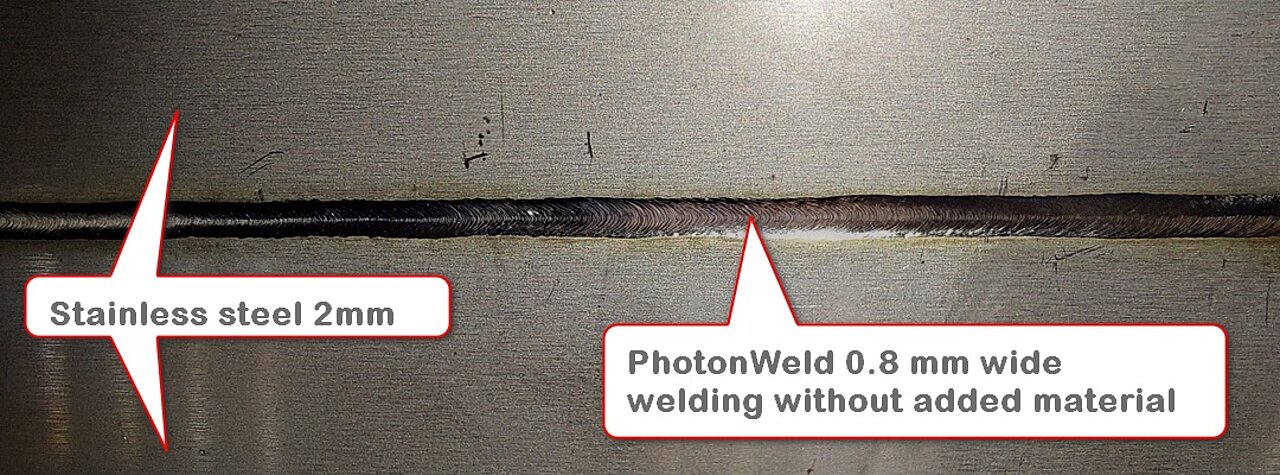
Autogenous Welding or Welding without wire infeed
Autogenous Welding:
- Materials are joined without the addition of extra materials which requires the highest level of fixturing and joint preparation. Since no material is added, it is necessary for the materials to be welded to remain in intimate contact during the welding process. Any significant separation of the materials can result in an unacceptable weld profile or complete failure of the welded joint. PhotonWeld Series prevent this to happen!
- Fixturing to ensure consistent fit-up of the weld joint is a key to successful fiber laser welding. An important benefit of fiber laser is welded joints with exceptional cosmetic appearance. In some cases, these welds are almost perfectly blended with the surrounding material. Depending on the fixturing and joint fit-up, some welds may have small amounts of concavity (which may not be acceptable for product designs that require fatigue properties similar to those of the base material) or convexity. Again PhotonWeld Series avoid this problems!
⇒ Laser Welding without added material : Autogenous Laser Welding
Materials are joined without the addition of extra materials which requires the highest level of fixturing and joint preparation. Since no material is added, it is necessary for the materials to be welded to remain in intimate contact during the welding process. Any significant separation of the materials can result in an unacceptable weld profile.
Good Fixturing to ensure consistent fit-up of the weld joint is a key to successful fiber laser welding. An important benefit of fiber laser is that the welded joints have an exceptional cosmetic appearance. In some cases, these welds are almost perfectly blended with the surrounding material. Depending on the fixturing and joint fit-up, some welds may have small amounts of concavity (which may not be acceptable for product designs that require fatigue properties similar to those of the base material) or convexity.
PhotonWeld: Laser Welding with material infeed
Additive Welding or welding with wire infeed
Additive Welding:
Material is added to the weld joint usually in the form of metallic wire . Three reasons for adding material to the weld are:
- Joint fit-up: By adding extra material, the joint becomes more tolerant to joint mismatch. Acceptable welds may be produced from joints with less than perfect fit-up.
- Weld geometry: Addition of filler metal is used to control the shape and size of the weld. Maintaining a crown (convex surface of the weld) creates a reinforcement which is important for joints requiring mechanical strength and fatigue life in the overall product’s design performance.
- Dissimilar metals: Filler metal is added to facilitate welding of dissimilar metals and alloys which are otherwise metallurgically incompatible.
⇒ Welding WITH added material : Additive Laser Welding
Material is added to the weld joint usually in the form of metallic wire.
Three reasons for adding material to the weld are:
- Joint fit-up: By adding extra material, the joint becomes more tolerant to joint mismatch. Acceptable welds may be produced from joints with less than perfect fit-up.
- Weld geometry: Addition of filler metal is used to control the shape and size of the weld. Maintaining a crown (convex surface of the weld) creates a reinforcement which is important for joints requiring mechanical strength and fatigue life in the overall product’s design performance.
- Dissimilar metals: Filler metal is added to facilitate welding of dissimilar metals and alloys which are otherwise metallurgically incompatible.
Wobble welding technology allows to skip the filler material while achieving a high quality welding seam if the gap is not too big.
Bridge wider gaps with our PhotonWeld Wobble technology
How to Determine Optimum Welding and Wire Speeds in Wire Feed Laser Welding ?
Laser beam – filler wire interaction:
An exposed length of wire that is too short prevents the wire from being melted at the initial area of the bead, and the laser beam directly affects the material to be melted. In turn, an exposed length of wire that is too long causes the extended wire end to be pressed against the plate surface, and as a result, at the initial stage, the laser beam melts the wire through, dividing it into two parts. In consequence, the spot at which the process starts is covered with a wire end welded onto the surface that is difficult to remove. In an extreme case, the welded-on wire end could cause a collision with the gas shielding nozzle, disturbing or even eliminating the gas shielding.
Wire feed delivery angle:
Angles between 30 and 60 degrees from the vertical can be used and 45 degree tends to be typical, as it simplifies setting the required wire intersection position with laser beam centerline. Angles greater than 60 degrees makes the latter difficult and angles less than 30 degrees causes the wire to intersect a large area of the laser beam, causing melting and vaporization of the wire without incorporating the metal into the weld pool.
Focused spot size:
The spot size should be close to the filler wire diameter. A laser spot size that is too small compared to the wire diameter can lead to welds with porosity because the filler wire has not melted properly.
Optimization and control of these parameters will lead to a consistent welding process and high quality weld.
Welding and filler wire speed:
The wire feed rate for a given weld joint gap and plate thickness is an important parameter and depends on welding speed, the cross sectional area of the gap between the joint face, and cross sectional area of the filler wire.
The relationship between welding speed and filler wire infeed is expressed as follows:
- Use of filler wire generally results in a 10% to 20% decrease in welding speed, for a given laser power, to compensate for the laser energy required to melt the wire.
- If the filler wire feed rate is too low, the amount of heat generated from the laser beam will affect the wire and the material being welded may be able to melt a bigger section of the wire end. This may result in breaking a liquid metal bridge formed during the process, the formation of a drop at the end of the wire, and momentary disturbance of the process stability.
- Too high filler wire feed rate causes the energy supplied to the welding area to be insufficient for stable and permanent wire melting. The volume of liquid metal at the end of the wire and in the liquid metal bridge increases thus flooding the air gap. Additionally, non-melted wire enters the back area of the pool, pushing out the liquid metal, which, by solidifying, forms characteristic humps of the weld surface and porosity at the root of the weld. Excessive wire speed can also reduce the penetration depth, weld width, and top bead height.
Why Use Filler Metal with Laser Welding?
Applications for which filler wire is added during laser welding include:
- Improve the joint fit-up tolerance (air gaps, mismatch, etc.) of the parts to be welded.
- Eliminate solidification cracking during welding. For some aluminum alloys wire is used to replace the low melting temperature alloys and reduce the freezing point during cooling. For welding 6XXX series aluminum alloys, high silicon content wire such as 4043 or 4047 leads to reduced cracking and improved mechanical properties of these weld.
- Modify the chemical composition or the microstructure of the weld metal to obtain suitable mechanical properties.
- Improve the weld profile such as to avoid undercut at the top and bottom bead. Excessive undercut can act as stress raiser, which can reduce the mechanical properties of the weld during the service.


